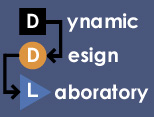|
|
 |

|
 |
Dynamic Design Laboratory
Vehicle Control and Driver Assistance Systems
With future drive-by-wire systems and new sensing opportunities provided by the Global Positioning System and
low-cost inertial sensors, new possibilities arise for the dynamics of driving. We are currently developing cars
with customizable handling that can match each driver's desires up to the very limits of tire friction and
lanekeeping assistance systems that nudge the vehicle away from road departure. We believe that a key design
constraint for all of these systems is that they should to assist the driver in a smooth, predictable and transparent
manner. The driver remains fully in command as our systems shape the dynamics to match the driver's wishes.
Combustion Control
Homogeneous charge compression ignition (HCCI) a process of autoigniting a well-mixed air and fuel charge could
conceivably offer the efficiency of a diesel engine without the problems of particulate and NOx emissions. However,
before this combustion process can be brought into a real engine, the autoignition process must be carefully
controlled. The combustion control group focuses on model-based approaches for controlling the phasing and work
output of HCCI and enabling multi-combustion-mode engines that can switch from spark ignition to HCCI as needed. Our
HCCI work builds on a close collaboration with Professor Chris Edwards in the Thermosciences Group and the desire to
remove traditional boundaries between control theory and thermodynamics.
Diagnostics for by-Wire Vehicles
Future automotive innovations such as steer-by-wire will only be deployed if the systems can offer performance and
safety better than conventional vehicles at a reasonable price point. This presents a challenge to diagnostic
systems that must quickly isolate and recover from any component failures without the added cost of triple
redundancy. Our research seeks to identify diagnostic structures that can offer guaranteed levels of performance and
safety by using models of the electrical and mechanical system dynamics to replace sensors. This work is
multi-modal, combining techniques such as parameter identification, Kalman filtering and a Bayesian network framework
that connects system models with varying confidence levels, ontologies and assumption sets.
Vehicle State and Parameter Estimation
Controlling a vehicle requires a the ability to measure or estimate its motion in three dimensions and to determine
parameters such as mass and tire properties. As a fundamental building block for all of our vehicle control work, we
have developed GPS-based approaches to estimate in real time the necessary states and model parameters. Currently,
we are investigating ways to include steering torque information in a manner analogous to a race car driver at the
limits of handling.
Lagrangian Systems
Lagrangian dynamics and differential geometry provide a rigorous mathematical framework for describing the behavior
of vehicles and other mechanical systems. In addition to deploying physical systems, we strive to use geometry to
interpret our results and synthesize new types of controllers.
|
|

